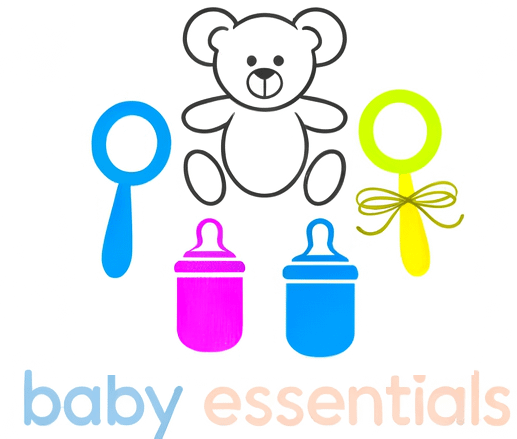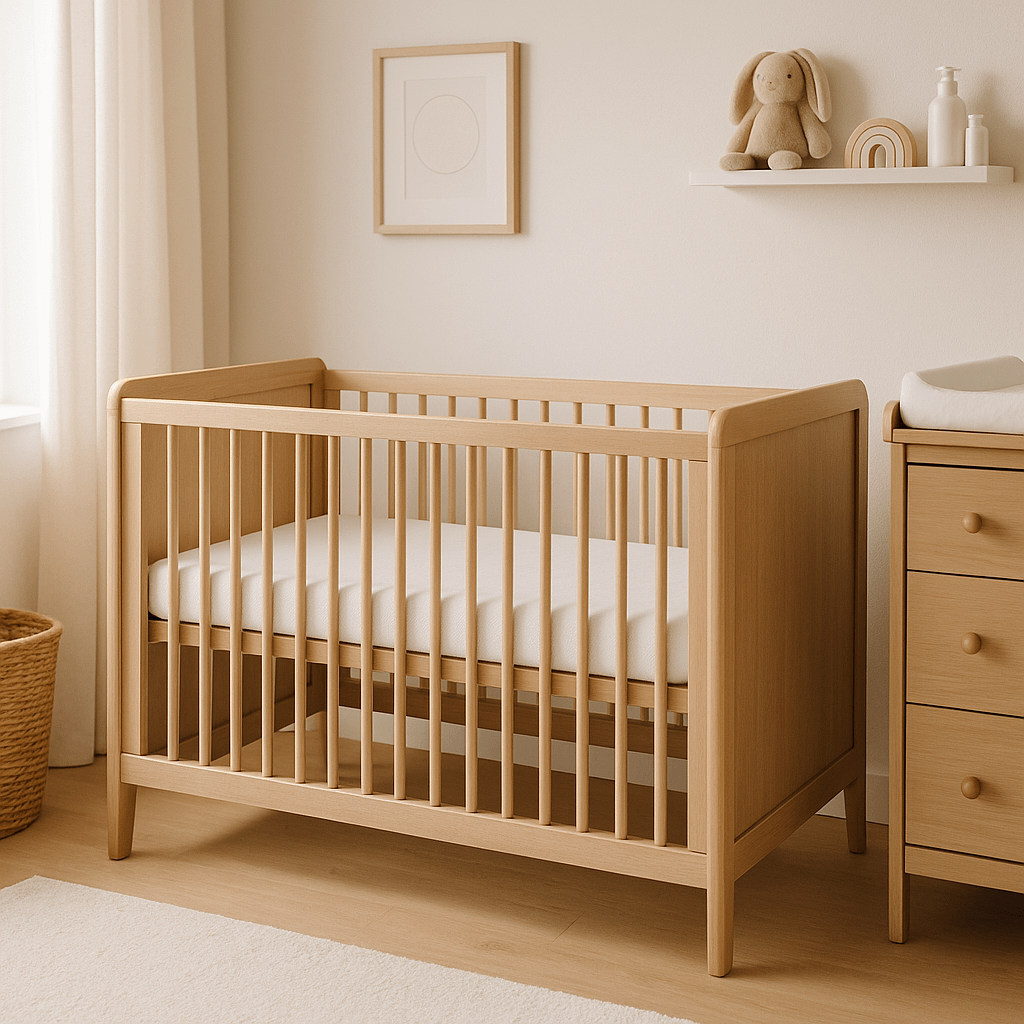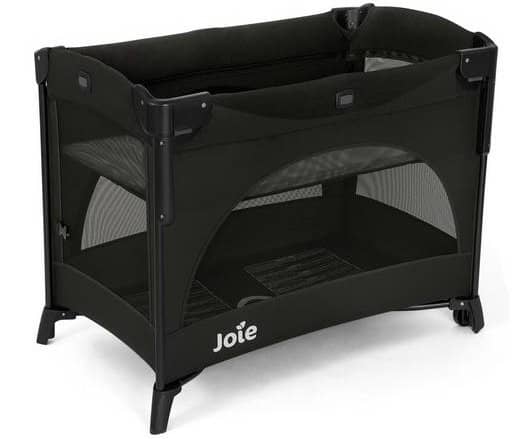Introduction to What to Look for in a Cot
Choosing your baby’s first cot is one of the most important decisions you’ll make as a new parent. With your little one spending up to 16 hours a day sleeping during their first few months, selecting the right cot isn’t just about aesthetics – it’s about creating a safe, comfortable environment that will support healthy sleep patterns and development for years to come.
The UK market offers countless options, from traditional wooden designs to modern convertible cot beds, each promising to be the perfect choice for your nursery. However, with recent changes to UK safety regulations and an overwhelming array of features to consider, many parents find themselves confused about what truly matters when making this crucial purchase.
This comprehensive guide, “What to Look for in a Cot”, will walk you through everything you need to know about choosing a cot in the UK, from understanding the latest safety standards to identifying the features that offer genuine value for money. Whether you’re expecting your first child or looking to upgrade from a Moses basket, this article will equip you with the knowledge to make an informed decision that prioritises your baby’s safety, comfort, and your peace of mind.
Key Takeaways
When choosing a cot for your baby, remember these essential points:
Safety First: Always look for UK safety certifications (BS EN 716-1:2008+A1:2013) and ensure bar spacing is between 2.5-6.5cm with at least 50cm height from mattress to cot top.
Essential Features: Prioritize adjustable mattress heights (3 positions), solid construction, and consider convertible cot beds for long-term value that can last until age 4-5.
Budget Wisely: Mid-range options (£200-£500) typically offer the best balance of safety and quality. Factor in additional costs like mattresses and bedding when budgeting.
Avoid Hazards: Never use cot bumpers, loose bedding, or toys with babies under 12 months. Ensure mattress fits with gaps no larger than 3cm.
Think Long-term: Convertible cot beds offer superior value, potentially serving from birth to school age, making them more economical than separate purchases.
Quality Matters: Choose solid wood construction over particle board for durability, especially if planning multiple children. Proper assembly and regular safety checks are crucial.
Remember: the most expensive cot isn’t necessarily the safest. Focus on UK safety compliance, quality construction, and features that genuinely benefit your family’s needs rather than aesthetic appeal alone.
Understanding UK Cot Safety Standards in 2025
Safety should always be your primary concern when selecting a cot, and fortunately, the UK has some of the world’s strictest safety standards for baby furniture. All cots sold in the UK must comply with specific British Safety Standards that have been designed to protect your child from potential hazards.
Current Safety Certifications
When shopping for a cot, you must look for products that display the BS EN 716-1:2008+A1:2013 marking. This certification ensures that the cot meets all essential safety requirements, including proper sizing, structural integrity, and appropriate spacing between components. For cot beds that convert into toddler beds, you should also look for the BS 8509 standard marking.
The European Safety Standard EN 716-1-2:2017 represents the most current safety requirements. Cots meeting this standard have undergone rigorous testing to ensure they can withstand the daily wear and tear of family life, including the inevitable wobbles, jumps, and bumps that come with active toddlers.
Critical Safety Measurements
Understanding the specific measurements required by UK safety standards will help you evaluate any cot you’re considering:
Bar Spacing Requirements: The distance between cot bars must be no less than 2.5cm and no more than 6.5cm. This precise spacing prevents your baby’s head, arms, or legs from becoming trapped while still allowing for proper ventilation and visibility.
Height Specifications: There must be at least 50cm between the top of the mattress and the top of the cot sides. This measurement is crucial for preventing your baby from climbing out as they grow more mobile, typically around 8-12 months of age.
Mattress Fit: The gap between the mattress edge and the cot frame should never exceed 3cm. A properly fitting mattress eliminates dangerous gaps where a baby could become trapped or injured.
Recent Regulatory Changes
The Furniture and Furnishings (Fire) (Safety) (Amendment) Regulations 2025 brought significant changes that came into effect on 30 October 2025. These amendments specifically exclude certain baby and children’s products from fire safety regulations, including cots, cribs, cradles, carry cots, bassinets, Moses baskets, travel cots, and bedside sleepers.
This change recognises that the fire risk for these products is much lower than the potential chemical exposure risk from flame retardants, particularly for babies and young children at a critical stage of development. The regulations also removed the requirement for manufacturers to affix display labels to new products and extended the timeframe for legal proceedings from 6 to 12 months.
Essential Features to Consider
Adjustable Mattress Heights
One of the most valuable features in any cot is an adjustable mattress base with multiple height positions. Most quality cots offer three different height settings, allowing you to adapt the sleeping space as your baby grows and develops new abilities.
Highest Position: When your baby is a newborn and cannot yet roll or sit up, the highest mattress position makes it easier for you to lift them in and out of the cot. This reduces strain on your back during those frequent night-time feeds and nappy changes.
Middle Position: As your baby begins to roll and show signs of increased mobility, typically around 4-6 months, you should lower the mattress to the middle position. This provides additional safety while still maintaining reasonable access.
Lowest Position: Once your baby can pull themselves up to standing, usually around 8-10 months, the mattress must be lowered to its lowest position. This is crucial for preventing falls and ensuring your child cannot climb out of the cot.
Convertible Cot Beds
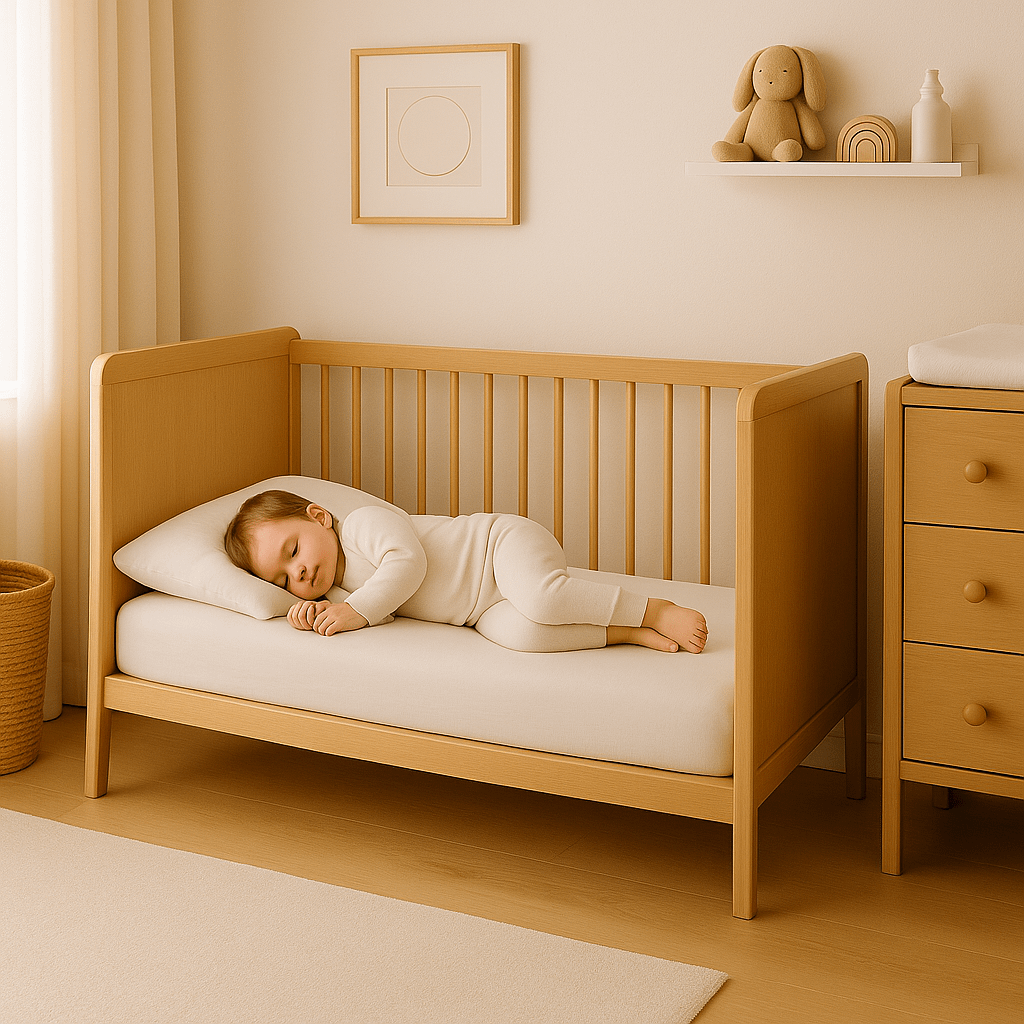
Cot beds offer exceptional value for money as they transform from a baby cot into a toddler bed, potentially lasting until your child is four years old. This conversion typically involves removing one or both sides of the cot and sometimes adjusting the mattress height to create a low bed suitable for independent access.
When evaluating convertible options, consider the conversion process itself. The best cot beds make this transition simple and tool-free, allowing you to adapt the furniture as your child’s needs change. Some models also include additional features like removable side barriers to prevent rolling out during the transition period.
Teething Rails and Protection
Teething typically begins around 5-6 months and continues until your child is 2-3 years old. During this period, many babies find relief by gnawing on their cot rails, which can damage both the furniture and potentially harm your child if wood splinters break off.
Quality cots often include teething rails – protective coverings made from silicone or safe fabric that run along the top edges of the cot sides. If your chosen cot doesn’t include these, they can be purchased separately and are a worthwhile investment for protecting both your furniture and your child.
Storage Solutions
Space is often at a premium in UK homes, making built-in storage an attractive feature. Some cots include drawers beneath the sleeping area, providing convenient space for bedding, clothes, or toys. However, ensure that any storage compartments don’t compromise the structural integrity of the cot or create additional safety hazards.
Mobility Features
Casters or wheels can be incredibly useful, especially if you plan to move the cot between rooms or need to access different sides for cleaning. Look for models with lockable wheels to ensure the cot remains stable during use while still offering mobility when needed.
Materials and Construction Quality
Wood Types and Finishes
Solid wood construction, particularly hardwoods like oak or beech, offers superior durability and longevity compared to particleboard or MDF alternatives. These materials can withstand years of use and often improve with age, making them excellent choices for families planning multiple children.
When evaluating wood finishes, prioritise products with low Volatile Organic Compound (VOC) paint finishes. These reduce harmful air pollutants in your home and are particularly important in nursery environments where your baby will spend significant time.
Construction Details
Pay attention to the quality of joints and overall construction. Well-made cots feature sturdy joints with proper reinforcement, preventing wobbling or creaking noises that could disturb sleep. Hand-crafted furniture often offers superior build quality, with attention to detail that mass-produced items may lack.
Examine all edges and corners, ensuring they are smooth and rounded to minimise injury risk. The overall finish should be consistent, with no rough patches or areas where paint might chip or flake off.
Hardware and Mechanisms
If you’re considering a cot with drop-sides, ensure it includes proper locking mechanisms that comply with current UK safety standards. The drop-side should operate smoothly and remain reliably in the raised position, with locks that cannot be operated by a child.
All hardware, including screws, bolts, and hinges, should be of high quality and properly secured. Regular inspection of these components should be part of your ongoing safety routine.
Size Considerations and Room Planning
Standard UK Cot Dimensions
Most UK cots are designed to accommodate standard mattress sizes, typically 120cm x 60cm for full-size cots. However, some compact models use smaller mattresses, such as 90cm x 60cm, which may be suitable for smaller spaces but will require replacement sooner as your child grows.
Room Layout and Positioning
The Lullaby Trust recommends that babies sleep in the same room as parents for the first six months. This means your cot needs to fit comfortably in your bedroom initially, before potentially moving to a separate nursery.
Position the cot away from windows, radiators, and any furniture that your child could use to climb out. Ensure there’s adequate space around the cot for safe access and consider how the room layout will work as your child becomes more mobile.
Future Space Requirements
If you’re choosing a convertible cot bed, consider how the converted bed will fit in your child’s room. Toddler beds require additional floor space for safe access and play, so ensure your room can accommodate this future configuration.
What to Avoid: Red Flags and Safety Concerns
Second-Hand Considerations
While purchasing second-hand furniture can save money, cots require particular caution. Never use a second-hand mattress, as it may not fit properly and could harbour bacteria or allergens. Always verify that any second-hand cot meets current safety standards and includes original instructions.
Inspect second-hand cots carefully for damage, wear, or modifications that could compromise safety. Missing or damaged hardware should be replaced with manufacturer-approved components only.
Dangerous Products and Practices
Recent investigations have revealed a concerning number of dangerous baby products entering UK homes. Avoid products that don’t clearly display safety certifications or come from unknown manufacturers without established safety records.
Never use cot bumpers, loose bedding, pillows, or toys in the cot with babies under 12 months. These items significantly increase the risk of suffocation and Sudden Infant Death Syndrome (SIDS).
Drop-Side Safety Concerns
While drop-sided cots remain legal in the UK when they meet current safety standards, they have been banned in other countries due to safety concerns. If you choose a drop-sided model, ensure it includes proper locking mechanisms and never leave your child unattended with the side lowered.
Budget Considerations and Value for Money
Price Ranges and What to Expect
UK cot prices vary dramatically, from budget options around £100 to premium models exceeding £1,000. However, price doesn’t always correlate with safety or quality. Focus on safety certifications and essential features rather than brand prestige or elaborate designs.
Mid-range cots (£200-£500) often offer the best balance of safety, quality, and features for most families. These typically include adjustable heights, solid construction, and convertible functionality without unnecessary premium features.
Long-Term Value
Convertible cot beds offer superior long-term value, potentially serving your child from birth to age four or beyond. When calculating cost-per-use, these models often prove more economical than purchasing separate cots and toddler beds.
Consider the durability and potential resale value when making your decision. Well-made cots from reputable manufacturers often retain significant value and can be safely passed on to other families.
Hidden Costs
Factor in additional costs beyond the cot itself, including mattresses, bedding, and any optional accessories like teething rails or storage solutions. Some manufacturers offer complete packages that may provide better value than purchasing components separately.
Setting Up Your Cot Safely
Assembly and Installation
Follow the manufacturer’s instructions precisely during assembly, ensuring all components are properly secured. Many cots require specific tools or techniques, so don’t attempt shortcuts that could compromise safety.
Consider professional assembly if you’re not confident in your DIY skills. The cost of professional installation is minimal compared to the potential consequences of improper assembly.
Mattress Selection and Fitting
Choose a firm, well-fitting mattress specifically designed for your cot model. The mattress should fit snugly with no gaps exceeding 3cm around the edges. Avoid mattresses with handles, as these can create entrapment hazards.
Ongoing Maintenance and Inspection
Regularly inspect your cot for loose components, wear, or damage. Tighten any loose screws or bolts immediately and replace damaged parts with manufacturer-approved components only.
Keep the cot environment clean and clutter-free, removing any items that could pose choking or strangulation hazards. As your child grows, reassess the safety setup and make necessary adjustments.
Special Considerations for Different Needs
Small Spaces and Compact Living
For families with limited space, consider compact cot designs or models with built-in storage to maximise functionality. Some cots are specifically designed for small rooms while still meeting all safety requirements.
Bedside cribs offer an alternative for very small spaces, allowing safe co-sleeping while maintaining separate sleep surfaces. These typically convert to standard cots as your baby grows.
Multiple Children and Siblings
If you’re planning multiple children, invest in a high-quality cot that will withstand repeated use. Solid wood construction typically offers better longevity than alternatives, making it more suitable for multiple children.
Consider the conversion timeline if you’re using a cot bed for multiple children. You may need the cot function again before the older child is ready to transition to a regular bed.
Special Needs Considerations
Some children may require specialised cots with additional safety features or extended use periods. These might include higher sides, specialised padding, or adjustable features to accommodate specific medical needs.
Consult with healthcare professionals if your child has special requirements that might affect their sleeping arrangements or safety needs.
Making Your Final Decision
Research and Comparison
Take time to research specific models and read reviews from other parents. Look for consistent feedback about quality, safety, and ease of use rather than focusing solely on aesthetic preferences.
Visit showrooms when possible to see and feel the construction quality firsthand. This can reveal details about build quality that aren’t apparent in online photos or descriptions.
Timing Your Purchase
Consider purchasing your cot during your second trimester, allowing time for delivery and setup while avoiding the stress of last-minute shopping. This also provides time to address any issues or concerns before your baby arrives.
Watch for sales and promotions, but don’t compromise on safety features to save money. The cost difference between a safe, quality cot and a premium model is often less significant than the potential consequences of choosing poorly.
Final Safety Check
Before using any cot, conduct a final safety inspection:
- Verify that all safety certifications are clearly displayed
- Ensure proper assembly with no loose components
- Confirm mattress fit with gaps no larger than 3cm
- Check that all height and spacing measurements meet UK standards
- Remove any packaging materials or potential hazards from the sleep area
2025 Gold Winner of Mother&Baby Awards for Best Cot/Crib
Conclusion
Choosing the right cot for your baby involves balancing safety, functionality, and budget considerations while navigating an increasingly complex marketplace. The most important factors remain unchanged: prioritise safety certifications, ensure proper construction and fit, and select features that will genuinely benefit your family’s needs.
Remember that the most expensive cot isn’t necessarily the safest or most suitable for your situation. Focus on UK safety standards compliance, quality construction, and features like adjustable heights and convertible functionality that offer genuine long-term value.
Take time to research your options thoroughly, but don’t let perfectionism delay your decision. Any cot that meets current UK safety standards and fits your space and budget requirements will provide a safe sleeping environment for your baby. The key is making an informed choice based on facts rather than marketing claims or aesthetic preferences alone.
Your baby’s safety and your peace of mind are worth the investment in quality furniture that will serve your family well for years to come. With the information provided in this guide, you’re well-equipped to make a confident decision that prioritises what truly matters: creating a safe, comfortable space where your little one can rest and grow.
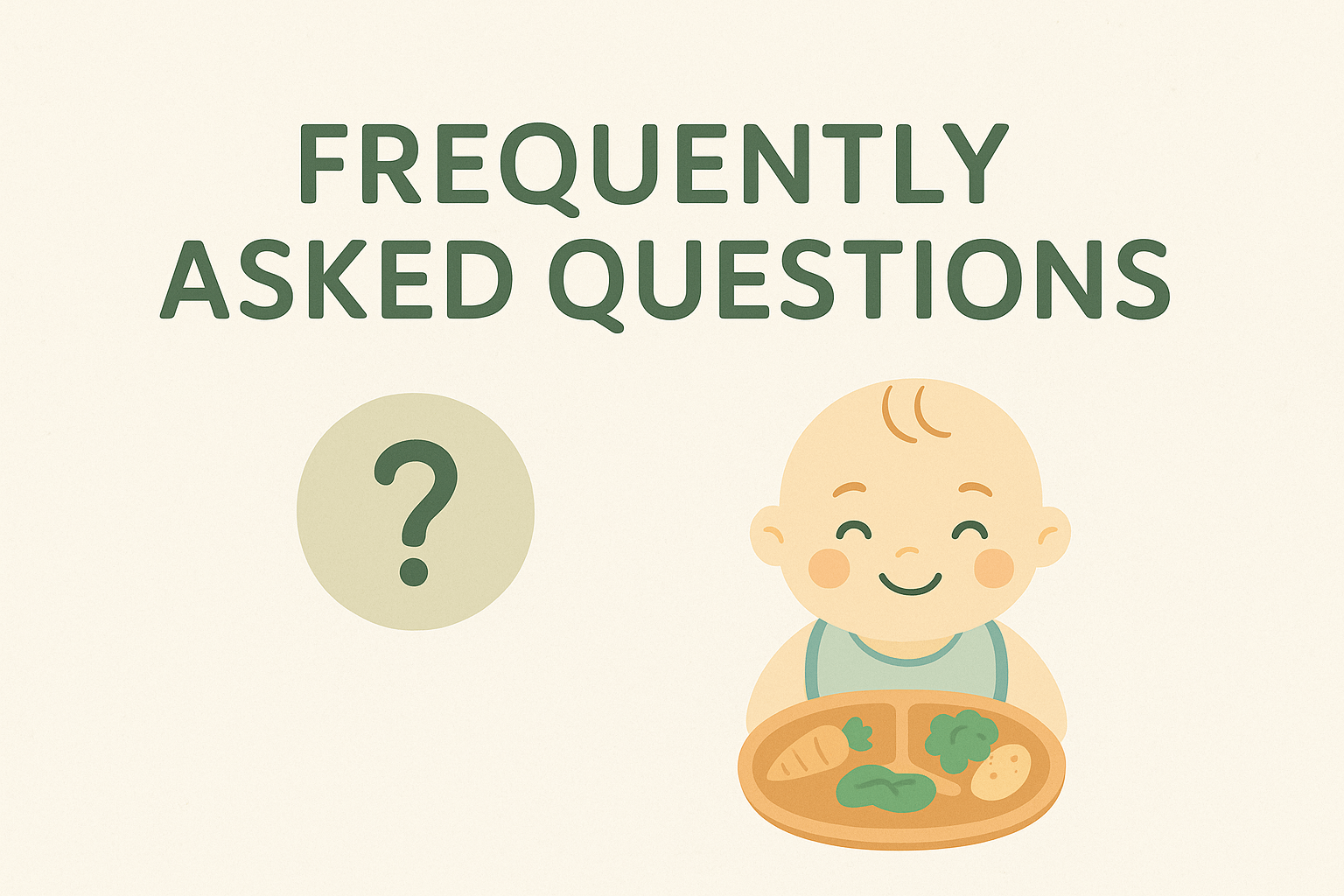
FAQs – What to Look for in a Cot
What safety standards should I look for when buying a cot in the UK?
When purchasing a cot in the UK, you must look for products that display the BS EN 716-1:2008+A1:2013 marking. This certification ensures that the cot meets all essential safety requirements, including proper sizing, structural integrity, and appropriate spacing between components. For cot beds that convert into toddler beds, you should also look for the BS 8509 standard marking. The most current safety requirements are represented by the European Safety Standard EN 716-1-2:2017. These standards ensure that cots have been rigorously tested for daily wear and tear, proper bar spacing (between 2.5cm and 6.5cm), and adequate height (at least 50cm between the mattress top and cot sides).
What’s the difference between a cot and a cot bed, and which should I choose?
A cot is your baby’s bed for the first couple of years, usually has fixed sides or one drop-side, and tends to fit smaller spaces.
A cot bed is essentially the same, but can be converted into a junior bed (toddler bed) by removing both sides once your child is ready. Cots are generally around 120cm long x 60cm wide, while cot beds are typically bigger, averaging 140cm long x 70cm wide. Cot beds offer exceptional value for money as they can last from birth until your child is around four to five years old, making them more cost-effective despite the higher initial investment. Choose a cot bed if you have space and want longevity; opt for a standard cot if space is limited or you’re planning multiple children close together.
How much should I expect to spend on a quality cot?
Cot prices vary significantly based on features and materials. Cots can start from as little as £60, but most fall within £100-300. Cot beds are generally more expensive, with prices ranging between £200-£700. However, cot beds can be more cost-effective in the long run since they’ll be in use for longer than a standard cot. Mid-range options (£200-£500) often provide the best balance of safety, quality, and features for most families. Remember to factor in additional costs like mattresses (at least £40 extra), bedding, and optional accessories like teething rails when budgeting for your purchase.
Are drop-sided cots safe to use in the UK?
Drop-sided cots remain legal and safe in the UK when they meet current safety standards, unlike in the US, where they’ve been banned since 2011. UK furniture safety experts believe that accidents are not possible with cot beds that comply with relevant British standards. The British and European safety standard was revised in 2011 and again in 2013, specifically addressing safety concerns. Drop-sided cots in the UK now require a lock on the drop sides when the cot is in the lowered position. If you choose a drop-sided model, ensure it displays the BS EN 716: 2005 marking and never leave your child unattended when the drop side is down.
What features are most important when choosing a cot?
The most essential features include adjustable mattress heights with typically three different positions. Start with the highest position for newborns (easier access), move to the middle position when your baby can roll (around 4-6 months), and use the lowest position once they can pull themselves up to standing (around 8-10 months). Teething rails are highly recommended since babies start cutting teeth around 5-6 months and continue until 2-3 years old. Other valuable features include sturdy construction (preferably solid wood), proper safety certifications, and if space allows, convertible functionality for long-term use.
How do I ensure the mattress fits properly and safely?
A properly fitting mattress is crucial for safety. There should be no gaps between the mattress and the cot frame exceeding 3cm. The mattress should fit snugly against all sides of the cot without any gaps to ensure a safe sleep surface. When shopping for a cot mattress, you need to buy one with the same dimensions as your cot bed or cot so that the mattress fits snugly into the frame. Choose a firm, well-fitting mattress specifically designed for your cot model, and avoid mattresses with handles as these can create entrapment hazards. Never use a second-hand mattress, as it may not fit properly and could harbour bacteria or allergens.
What should I avoid when buying a cot?
Avoid cots that don’t clearly display safety certifications or come from unknown manufacturers without established safety records. Never use cot bumpers, loose bedding, pillows, or toys in the cot with babies under 12 months, as these significantly increase the risk of suffocation and SIDS.
When buying second-hand, be particularly cautious – always verify that any second-hand cot meets current safety standards, inspect for damage or modifications, and never use a second-hand mattress. Avoid cots with bar spacing outside the safe range (must be between 2.5cm and 6.5cm), and check that there are no loose parts, wobbly joints, or sharp edges. Also, avoid cots with decorative cut-outs or steps that could create climbing hazards or entrapment risks.
Further Reading
- Essential Baby Sleep Tips for New Parents
- Ickle Bubba Snowdon Mini Cot Bed Review: Stylish 4-in-1 Convertible Design
- UK Baby Product Safety Standards 2025: Your Complete Parent’s Guide
- Snuz SnuzPod4 Bedside Crib
- Sibling Room Sharing v Separate Bedrooms
- Your Guide to Safe Sleep for Baby (2025 Update)
- Understanding Baby Sleep Cycles: A Comprehensive Guide for Parents
References
- UK Government. Furniture and Furnishings (Fire) (Safety) (Amendment) Regulations 2025. gov.uk
- Intertek. UK Published the Amendments to The Regulations On The Fire Safety of Furniture. May 2025
- Babymore. Cot Safety Guide. December 2023
- CuddleCo. How to Choose the Right Cot Bed For Your Baby
- Made for Mums. 10 of the best cots and cot beds for babies and toddlers 2025. March 2025
- Venicci. Choosing Baby’s First Bed: Tips and Advice. June 2024
- Theraposture. Mascot Mk2 care cot case study. July 2021
- Lewisham Community and Voluntary Sector. Suffocation, overheating and death – dangerous baby products in UK homes
- Good Housekeeping UK. Best cots and cot beds to keep your baby snug and safe. June 2025
- Which? How to buy the best cot or cot bed. May 2025
- Boori UK. How to Ensure Your Cot Bed is Safe
- The Baby Cot Shop. Sweet Dreams, Happy Baby: Essential Features to Look for in a Baby Cot Bed. September 2023
- University of Bristol. Bristol research leads to a worldwide fall in the number of cot deaths
- My First Nursery. A Deep Dive into Nursery Furniture Safety Standards
- Boori UK. How to Choose Your Baby’s Cot – Cot Buying Guide. November 2023
